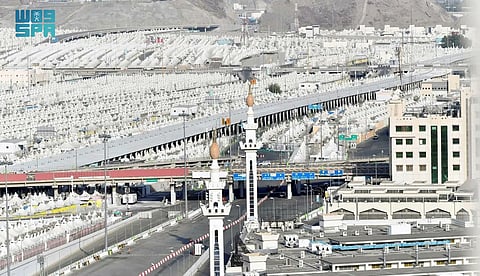Saudi Arabia readies for Hajj: 400 buses, 200-bed hospital prepared for pilgrims
36,000 square metres of pedestrian paths and 10,000 trees planted in Mecca

Dubai: The Royal Commission for Mecca City and the Holy Sites has announced its readiness for the Hajj season of 1446 AH through a series of high-quality projects and initiatives, focusing on the central region and the holy sites.
The commission said this year’s development strategy includes improvements in infrastructure, transportation systems, and field and health services.
In the central area, pedestrian environments have been enhanced with widened sidewalks and shaded walkways, and prayer spaces have been designated to improve the flow of people and distribute crowds effectively.
Regarding transportation, the General Transportation Centre, under the Royal Commission and responsible for overseeing transportation during Hajj, has implemented its operational plan for the season. This includes operating the “Mecca Buses” system, designed to meet the season’s demands.
From the 15th of Dhu Al Qa’dah to the 30th of Dhu Al Hijjah, 400 buses will operate on 12 routes, covering 431 stops and four central stations. The plan aims to enhance operational efficiency in high-density routes through coordination with the General Transport Syndicate and relevant authorities.
High-capacity locations have been allocated for the “Mecca Taxi” service, and service operations will be managed through contracts with providers to ensure smooth and reliable transportation during the season.
As part of enhancing the quality of services and ensuring comfort and safety for pilgrims, development work in Muzdalifah includes a designated pedestrian path spanning 170,000 square meters with rubber flooring, along with the planting of 10,000 trees to reduce heat stress and provide shade along the paths.
Field developments in Mina include the establishment of a 200-bed hospital, as well as 71 emergency centres strategically located along the routes to provide first aid and logistical support.
Rest areas with shaded seating and 400 newly operational water coolers have been installed to ensure constant access to water throughout the season.
To increase capacity, two-storey tent units were constructed to enhance housing services, and multi-storey restrooms were built, expanding the pilgrim camps and improving space distribution within the holy sites.
As part of the innovative initiatives, the “electric scooter” service, which was introduced last year, will continue to be available, with three dedicated routes to support light transportation options and facilitate the movement of pilgrims during their rituals.
Additionally, the Royal Commission launched its media campaign for the 1446 Hajj season, aimed at showcasing these projects and initiatives, offering documented content that follows the various stages of Hajj.
Huda Ata is an independent writer based in the UAE
Sign up for the Daily Briefing
Get the latest news and updates straight to your inbox



